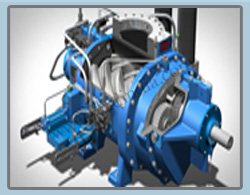Mechanical 3D Modeling
Mechanical 3D modeling involves creating three-dimensional digital representations of mechanical components, assemblies, and systems using specialized software tools.
- There are several software options available for mechanical 3D modeling, with Autodesk Inventor, SolidWorks, CATIA, and PTC Creo being some of the most popular choices. These software packages offer comprehensive tools specifically designed for mechanical design and engineering tasks.
- Mechanical 3D modeling software allows engineers and designers to create detailed 3D models of mechanical parts and assemblies. They can use features such as extrusions, revolves, sweeps, lofts, and fillets to build complex shapes and geometries.
- Parametric modeling is a key feature of mechanical 3D modeling software. It enables designers to create intelligent models with dimensions, constraints, and relationships that drive the geometry. This parametric approach allows for easy modification of designs and ensures consistency throughout the design process.
- Mechanical 3D models serve as the basis for generating various types of documentation, including engineering drawings, part lists, bill of materials (BOM), assembly instructions, and manufacturing specifications. These documents are essential for communicating design intent and facilitating the manufacturing process.
- Mechanical 3D modeling software often supports collaborative workflows, allowing multiple users to work on the same project simultaneously. Design changes and revisions can be tracked and managed efficiently, and users can communicate through comments, annotations, and markups.
Software :
3D Modeling :
Parametric Design :
Documentation :
Collaboration :








